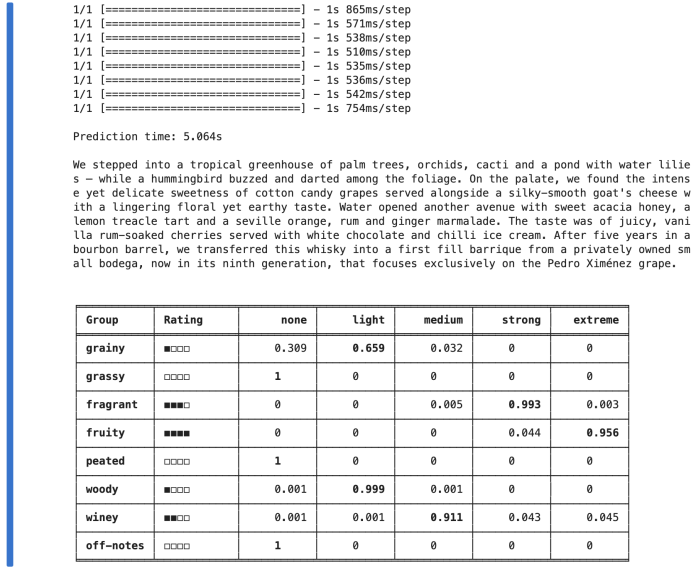Language Models for the Classification of Whisky Reviews
AI
Jan 2024
Whisky Tasting Notes
As a devoted whisky drinker and enthusiast, my focus has been on describing and classifying flavor profiles of whiskies.
“Whisky Tasting Notes” aim to put the complex aromas into words and have sometimes developed into an art form.
Here is an example note for the smoky taste of an “Ardbeg Uigeadail”:
„Full flavoured and rich with a deep mouth-coating texture, the taste is an intriguing balance between sweet, spicy and deep smoky flavours. The flavour is initially sweet. A burst of winter spices sets off a smoky-spicy explosion countered by a sumptuous mid-palate of honey glazed smoked food and chewy treacle. Waves of deep smoky tones and rich aromas build up on the palate like a fine Montecristo cigar. Amazingly long and chewy with lingering raisiny, deep mocha tones and rich aromatic smoke into the perfectly integrated finish.“
Whisky Tasting Wheel
“Whisky Tasting Wheels” are used to graphically represent the taste of different whiskies and make them comparable.
My categorization is based on the Whisky Wheel by author and whisky connoisseur Charles Maclean and is divided into 8 groups:
Grainy (Breakfast Cereal, Cornflakes, Porridge, Bran, Toast, Digestive Biscuits — Malt, Malt Coffee, Malt Barn, dried Hops)
Grassy (Cut Grass, Green Vegetables, Green Sticks, leafy, Mint — Hay, Straw, dried Tea, stewed Tea, Tobacco, dried Herbs)
Fragrant (perfumed, Rose, Lavender, Carnation — Bubble-gum, fresh Paint, Acetone, Pine Essence — Clover flowers, Heather Honey, Mead, Beeswax)
Fruity (Apple, Pear, Peach, Melon, Fig, Cherry, green Banana, Redcurrant — Lemon, Orange, Mandarin, Grapefruit, Pineapple — Raisins, Figs, Xmas Cake, Marmalade — tinned Peaches, tinned Pears, Fruit Salad, Lychees)
Peaty (Peat Smoke, Wood Smoke, Kippers, smoked Bacon, Tar — Elastoplast, Hospitals, Antiseptic, Iodine — Sphagnum Moss, Brine, Seaweed, Shellfish, fresh Fish)
Woody (Vanilla, Ice Cream, Custard, Caramel, Syrup — Clove, Nutmeg, Cinnamon, Liquorice, Ginger, Pepper, Coffee — Resin, Sawdust, Pencil Shavings, Cigar Boxes, Sandalwood)
Winey (Coconut, Linseed Oil, Almond, Walnut, Hazelnut — Butter, Vegetable Oil, Chocolate, Olive, Candlewax — White Wine, Sherry, Red Wine, Port, Wine Cellar)
Off-Notes (Vinegar, inky, metallic, rusty — earthy, fusty, mouldy, corked, damp Wool — brackish, Drains, Bogs — Cheese, rancid, yeasty, sweaty — Leather, Sausages, Gravy — Linen, Rubber, struck Matches)
Multiclass Text Classification
To classify whisky reviews, I trained 8 language models. These are “Multiclass Text Classification” models. The probability of belonging to the classes is calculated: e.g. 0 – not smoky , 1 – slightly smoky , 2 – moderately smoky , 3 – heavily smoky , 4 – extremely smoky.
Each language model for whisky review analysis was trained on a dataset of 20,000+ whisky reviews, a mix of synthetic and human-written samples.
The language models are based on the pre-trained LM BERT (Bidirectional Encoder Representations from Transformers) and were trained in 25 epochs.

Example of the classification of a whisky tasting note. The text is from The Scotch Malt Whisky Society and describes a 10 year old Glenfarclas.